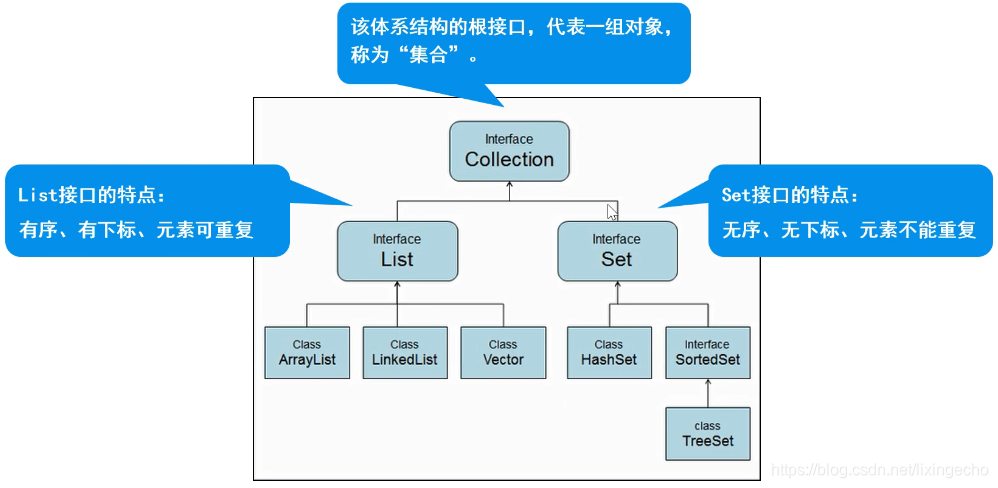集合概述:
-
概念:对象的容器,定义了对多个对象进项操作的的常用方法。可实现数组的功能。
-
和数组的区别:
-
数组长度固定,集合长度不固定。
-
数组可以存储基本类型和引用类型,集合只能存储引用类型。
-
-
位置: java.util.*;
一、Collection体系集合

Collection父接口
-
特点:代表一组任意类型的对象,无序、无下标、不能重复。
- Collection父接口有list和set两个子接口,list是 有序 、 有下标、可重复的,但set 无序、无下标,不能重复。
- 所以整体而言,我们将Collection视为无序、无下标、不能重复;但实际上,在api当中,认为Collection父接口是部分有序可重复、部分无序不可重复的。
-
方法:
boolean add(Object obj) //添加一个对象。
boolean addAll(Collection c) //将一个集合中的所有对象添加到此集合中。
void clear() //清空此集合中的所有对象。
boolean contains(Object o) //检查此集合中是否包含o对象。
boolean equals(Object o) //比较此集合是否与指定对象相等。
boolean isEmpty() //判断此集合是否为空。
boolean remove(Object o) //在此集合中移除o对象。
int size() //返回此集合中的元素个数。
Object[] toArray() //姜此集合转换成数组。
- Collection接口方法的使用:
(一)Collection集合保存 string字符串
/**
* Collection接口的使用(一)
* 1.添加元素
* 2.删除元素
* 3.遍历元素
* 4.判断
*/
public class Demo1{
pubic static void main(String[] args){
//创建集合
Collection collection=new ArrayList();
// * 1.添加元素
Collection.add("苹果");
Collection.add("西瓜");
Collection.add("榴莲");
System.out.println("元素个数:"+collection.size()); // 3
System.out.println(collection); // 【苹果,西瓜,榴莲】
// * 2.删除元素
collection.remove("榴莲");
System.out.println("删除之后:"+collection.size()); // 2
collection.clear();
System.out.println("清空之后:"+collection.size()); // 0
// * 3.遍历元素
//3.1 使用增强for (foreach 回车)
for(Object object : collection){
System.out.println(object); // 苹果 西瓜 榴莲
}
//3.2 使用迭代器(迭代器:专门用来遍历集合的一种方式)
//hasnext(); 判断是否有下一个元素
//next(); 获取下一个元素
//remove(); 删除当前元素(必须使用迭代器的删除方法,不能使用collection.remove() ,否则会引发错误)
Iterator iterator=collection.Itertor();
while(iterator.hasnext()){
String s=(String)iterator.next();
System.out.println(s); // 苹果 西瓜 榴莲
//删除操作
//collection.remove(s);引发错误:并发修改异常 java.util.ConcurrentModificationException
//iterator.remove();应使用迭代器的删除方法
}
// * 4.判断
System.out.println(collection.contains("西瓜")); //true
System.out.println(collection.isEmpty()); //false
}
}
}
(二)Collection集合保存 学生信息(学生类)
/**
* Collection接口的使用(二)
* 1.添加元素
* 2.删除元素
* 3.遍历元素
* 4.判断
*/
public class Demo2 {
public static void main(String[] args) {
//新建Collection对象
Collection collection=new ArrayList();
//实例化,创建学生对象
Student s1=new Student("张三",18);
Student s2=new Student("李四", 20);
Student s3=new Student("王五", 19);
//1.添加数据
collection.add(s1);
collection.add(s2);
collection.add(s3);
//collection.add(s3);可重复添加相同对象
System.out.println("元素个数:"+collection.size()); // 3
System.out.println(collection.toString());
//2.删除数据
collection.remove(s1);
System.out.println("删除之后:"+collection.size()); // 2
//3.遍历数据
//3.1 增强for
for(Object object:collection) {
Student student=(Student) object;
System.out.println(student.toString());
}
//3.2迭代器
//迭代过程中不能使用collection的删除方法
Iterator iterator=collection.iterator();
while (iterator.hasNext()) {
Student student=(Student) iterator.next();
System.out.println(student.toString());
}
//4.判断和上一块代码类似。
}
}
























 467
467











 被折叠的 条评论
为什么被折叠?
被折叠的 条评论
为什么被折叠?








